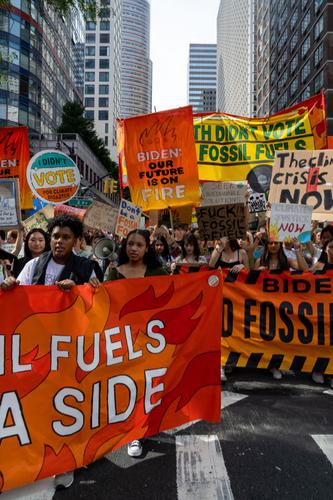

DEFINITION
Bill McKibben
Author, Educator, Environmentalist, and Co-Founder of 350.org
This significant number comes from the work of Harvard political scientist Erica Chenoweth, whose global database of nonviolent social protests finds that when that percentage of citizens engage in a peaceful civil uprising, they are nearly certain to win (Chenoweth also finds that nonviolent resistance is twice as successful as the use of force.)
There are 8 billion people on the planet; that would imply the climate crisis requires a movement of 280 million people, which is a lot of human beings, but easier to imagine than, say, 50%.
In a sense, the rule recognizes that most people most of the time will be apathetic and uninvolved, which makes it hard to mount an uprising, but also hard to stop one once it gets started, especially if there's no violence to repulse bystanders.
Historians, Chenoweth notes, have tended to fixate on violent upheavals, and so have the movies – but “ordinary people, all the time, are engaging in pretty heroic activities that are actually changing the way the world – and those deserve some notice and celebration as well.”

On Sunday September 17, 2023, 75,000 climate organizers, activists, and frontline community members from around the world gathered in New York City for the March to End Fossil Fuels with Fridays for Future. New York, USA, 2023.
Photography By Pamela EA
RESEARCH
Text by Zahra Saifee
Research by Estelle Ngoumtsa
Fact-checked by Hailey Basiouny
June 10, 2024
*text is up to date, although pending graphic adjustments
The 3.5% rule states that “no government has withstood a challenge of 3.5% of their population mobilizing against it during a peak event.” In the simplest terms, this means that there is strength in numbers, and this percentage of people mobilized for a cause can change a governmental stance and the wider public opinion. Erica Chenoweth, a political scientist, examined literature and data on social movements from 1900 to 2006, and found that when 3.5% of the population actively participates in nonviolent protests it can lead to significant political change.
Chenoweth’s 3.5% research builds on political scientist Mark Lichbach’s book ‘The Rebel’s Dilemma’, which hypothesizes that no government can maintain the status quo when 5% of its population is challenging it. Conversely, Lichbach argues that no movement can mobilize 5% of the population, because people are more likely to free-ride than engage in actions that are personally risky during a movement., Chenoweth found that movements that engaged at least 3.5% of the population during peak participatory periods succeeded in changing governmental stance or public opinion. Furthermore, movements that engaged more than 3.5% of the population were largely nonviolent.
Chenoweth’s research revealed that nonviolent protests were twice as likely to succeed than violent conflicts. Specifically, nonviolent campaigns were 53% more likely to lead to political change as opposed to 26% by violent protests. Due in part to the strength afforded by numbers, nonviolent protests appeal to a much broader demographic of people, which in turn creates more disruption of the status quo.In the case of building power and sustaining a movement, it comes down to how many people are willing to actively engage in various forms of protest, and continue over a long time period rather than a single occurrence.
Strikes are among the most powerful forms of protest, however, they require individual sacrifice and are not always accessible to people in the working class or those with disabilites. The key to successful movements includes actions that a majority of people can participate in while still upturning the status quo. One example is the consumer boycotts during the apartheid-era in South Africa, where citizens who were black refused to buy products from companies with white owners. This movement was built and sustained over decades, eventually leading to global action in the form of South African goods divestment and ultimately the end of apartheid.
Diversity of actions within a movement is just as important as the quantity of actions. As seen in the movement building for a free and liberated Palestine, people are engaging in protests, boycotts, divestments, encampments, and other forms of virtual and in-person activism. Starting with the encampment at Columbia University in support of Gaza, students occupied parts of campus and engaged in forms of peaceful protest and resistance. This sparked a global movement of university students staging their own encampments in solidarity with Palestine. Over 200 university encampments actively joining the global movement for an end to the ongoing genocide in Palestine, and continue to pressure their universities to divestment from Israeli-based companies and companies profiting from the genocide. Marches continue to happen in cities across the globe, with the United States march in Washington DC on November 4th drawing crowds of 100,000- 300,000 people. These actions are important in a sustained movement, and continue to engage, educate, and mobilize.
The 3.5% figure is motivation for movements, but it is a descriptive statistic based on Chenoweth’s historical data, not a prescriptive one. It has limitations and exceptions. Other factors in a movement such as momentum, organization, and strategic leadership matter as well. Additionally, the data that Chenoweth used to produce the 3.5% figure was produced through the research of violent and nonviolent movements challenging autocratic governments, not liberal democratic states such as the United States or the United Kingdom. How systems/ governments are changed within liberal democratic states varies greatly and can not always be predicted. This research also does not factor in the age of digital activism, which lowers the barriers of participation, like signing an online petition or posting something on social media. Social media can grow movements and spread knowledge at a much faster rate but the translation to sustained action in person is still to be questioned.
A movement needs numbers - people engaging at all levels through diverse actions. The 3.5% figure acts as a rule of thumb and target for building a sustained, successful movement. People are the core of a movement, so motivating each other, building solidarity, encouraging creativity, and finding ways to sustain ourselves and others as we work to see a better world is the ultimate goal.
Chenoweth, Erica. 2020. Review of Questions, Answers, and Some Cautionary Updates Regarding the 3.5% Rule. CARR CENTER for HUMAN RIGHTS POLICY HARVARD KENNEDY SCHOOL.
Robson, David. 2019. “The ’3.5% Rule’: How a Small Minority Can Change the World.” Bbc.com. BBC Future. May 13, 2019.
Gary L. Francione. 2012. “Erica Chenoweth: Why Civil Resistance Trumps Violent Uprisings - Columbia University Press Blog.” September 20, 2012.
Mathews, K. R., 2021. “Social Movements and the (Mis)Use of Research: Extinction Rebellion and the 3.5% Rule.” The Commons. November 29, 2021.
Ball, James. 2023. “The ‘3.5% Rule’ Needs Protesting.” The New European. October 17, 2023.
RELATED WORDS
We use cookies to analyze site usage and enhance navigation. By accepting, you agree to our use of cookies. Accept
Subscribe to our newsletter and be the first to get news on climate literacy!

By submitting I confirm that I have read Climate Words’ privacy policy and agree that Climate Words may send me announcements to the email address entered above and that my data will be processed for this purpose in accordance with Climate Words’ privacy policy.